Optimizing Oxygen Exposure during Kombucha Brewing Using Air-Permeable Silicone Bags
Abstract
1. Introduction
2. Materials and Methods
2.1. Preparation of Fermented Brews
2.2. Measurement of pH
2.3. Determination of Titratable Acidity
2.4. Determination of Dissolved Oxygen Concentrations
2.5. Quantification of Ethanol
2.6. Quantification of Acetic Acid and Gluconic Acid
2.7. Determination of Sugar Concentration
3. Results
3.1. Part 1—Sucrose Food Source
3.2. Part 2—Glucose and Fructose Food Sources
3.3. Part 3—Mimicking a Batch-Brewing Process
4. Discussion
5. Conclusions
Author Contributions
Funding
Institutional Review Board Statement
Informed Consent Statement
Data Availability Statement
Conflicts of Interest
References
- Antolak, H.; Piechota, D.; Kucharska, A. Kombucha Tea—A Double Power of Bioactive Compounds from Tea and Symbiotic Culture of Bacteria and Yeasts (SCOBY). Antioxidants 2021, 10, 1541. [Google Scholar] [CrossRef] [PubMed]
- Jakubczyk, K.; Kałduńska, J.; Kochman, J.; Janda, K. Chemical Profile and Antioxidant Activity of the Kombucha Beverage Derived from White, Green, Black and Red Tea. Antioxidants 2020, 9, 447. [Google Scholar] [CrossRef] [PubMed]
- Dufresne, C.; Farnworth, E. Tea, Kombucha, and Health: A Review. Food Res. Int. 2000, 33, 409–421. [Google Scholar] [CrossRef]
- Miranda, J.F.; Ruiz, L.F.; Silva, C.B.; Uekane, T.M.; Silva, K.A.; Gonzalez, A.G.M.; Fernandes, F.F.; Lima, A.R. Kombucha: A Review of Substrates, Regulations, Composition, and Biological Properties. J. Food Sci. 2022, 87, 503–527. [Google Scholar] [CrossRef] [PubMed]
- May, A.; Narayanan, S.; Alcock, J.; Varsani, A.; Maley, C.; Aktipis, A. Kombucha: A Novel Model System for Cooperation and Conflict in a Complex Multi-Species Microbial Ecosystem. PeerJ 2019, 7, e7565. [Google Scholar] [CrossRef] [PubMed]
- Coton, M.; Pawtowski, A.; Taminiau, B.; Burgaud, G.; Deniel, F.; Coulloumme-Labarthe, L.; Fall, A.; Daube, G.; Coton, E. Unraveling Microbial Ecology of Industrial-Scale Kombucha Fermentations by Metabarcoding and Culture-Based Methods. FEMS Microbiol. Ecol. 2017, 93, 1–16. [Google Scholar] [CrossRef]
- Huang, X.; Yongping, X.; Ting, L. A Systematic, Complexity-Reduction Approach to Dissect the Kombucha Tea Microbiome. eLife 2022, 11, e76401. [Google Scholar] [CrossRef] [PubMed]
- Tran, T.; Grandvalet, C.; Verdier, F.; Martin, A.; Alexandre, H.; Tourdot-Maréchal, R. Microbial Dynamics between Yeasts and Acetic Acid Bacteria in Kombucha: Impacts on the Chemical Composition of the Beverage. Foods 2020, 9, 963. [Google Scholar] [CrossRef] [PubMed]
- Tran, T.; Grandvalet, C.; Verdier, F.; Martin, A.; Alexandre, H.; Tourdot-Marechal, R. Microbiological and Technological Parameters Impacting the Chemical Composition and Sensory Quality of Kombucha. Compr. Rev. Food Sci. Food Saf. 2020, 19, 2050–2070. [Google Scholar] [CrossRef]
- Li, R.; Xu, Y.; Chen, J.; Wang, F.; Zou, C.; Yin, J. Enhancing the Proportion of Gluconic Acid with a Microbial Community Reconstruction Method to Improve the Taste Quality of Kombucha. LWT 2022, 155, 112937. [Google Scholar] [CrossRef]
- Oliveira, Í.A.C.L.D.; Rolim, V.A.D.O.; Gaspar, R.P.L.; Rossini, D.Q.; de Souza, R.; Bogsan, C.S.B. The Technological Perspectives of Kombucha and Its Implications for Production. Fermentation 2022, 8, 185. [Google Scholar] [CrossRef]
- Cvetkovic, D.; Markov, S.; Djuric, M.; Savic, D.; Velicanski, A. Specific Interfacial Area as a Key Variable in Scaling-up Kombucha Fermentation. J. Food Eng. 2008, 85, 387–392. [Google Scholar] [CrossRef]
- Villarreal-Soto, S.; Beaufort, S.; Bouajila, J.; Souchard, J.; Taillandier, P. Understanding Kombucha Tea Fermentation: A Review. J. Food Sci. 2018, 83, 580–588. [Google Scholar] [CrossRef] [PubMed]
- Anderson, M.; Kazantseva, J.; Kuldjarv, R.; Malv, E.; Vaikma, H.; Kaleda, A.; Kutt, M.; Vilu, R. Characterization of Chemical, Microbial and Sensory Profiles of Commercial Kombuchas. Int. J. Food Microbiol. 2022, 373, 109715. [Google Scholar] [CrossRef] [PubMed]
- Jayabalan, R.; Malbaša, R.V.; Lončar, E.S.; Vitas, J.S.; Sathishkumar, M. A Review on Kombucha Tea-Microbiology, Composition, Fermentation, Beneficial Effects, Toxicity, and Tea Fungus. Compr. Rev. Food Sci. Food Saf. 2014, 13, 538–550. [Google Scholar] [CrossRef]
- Goh, W.N.; Rosma, A.; Kaur, B.; Fazilah, A.; Karim, A.A.; Bhat, R. Microstructure and Physical Properties of Microbial Cellulose Produced During Fermentation of Black Tea Broth (Kombucha). II. Int. Food Res. J. 2012, 19, 153–158. [Google Scholar]
- Mousavi, S.M.; Hashemi, S.A.; Zarei, M.; Gholami, A.; Lai, C.W.; Chiang, W.H.; Omidifar, N.; Bahrani, S.; Mazraedoost, S. Recent Progress in Chemical Composition, Production, and Pharmaceutical Effects of Kombucha Beverage: A Complementary and Alternative Medicine. Evid.-Based Complement. Altern. Med. 2020, 2020, 4397543. [Google Scholar] [CrossRef]
- Gaggìa, F.; Baffoni, L.; Galiano, M.; Nielsen, D.; Jakobsen, R.; Castro-Mejía, J.; Bosi, S.; Truzzi, F.; Musumeci, F.; Dinelli, G.; et al. Kombucha Beverage from Green, Black and Rooibos Teas: A Comparative Study Looking at Microbiology, Chemistry and Antioxidant Activity. Nutrients 2018, 11, 1. [Google Scholar] [CrossRef] [PubMed]
- Neffe-Skocińska, K.; Sionek, B.; Ścibisz, I.; Kołożyn-Krajewska, D. Acid contents and the effect of fermentation condition of Kombucha tea beverages on physicochemical, microbiological and sensory properties. CyTA—J. Food 2017, 15, 601–607. [Google Scholar] [CrossRef]
- Miranda, B.; Lawton, N.M.; Tachibana, S.R.; Swartz, N.A.; Hall, W.P. Titration and HPLC Characterization of Kombucha Fermentation: A Laboratory Experiment in Food Analysis. J. Chem. Educ. 2016, 93, 1770–1775. [Google Scholar] [CrossRef]
- Ewards, J. Quantitative H NMR Analysis of “Off-the-Shelf” Commercial Kombucha Beverages; NMR-089; Process NMR Associates LLC.: Danbury, CT, USA, 2016. [Google Scholar]
- Landis, E.; Fogarty, E.; Edwards, J.; Popa, O.; Eren, A.; Wolfe, B. Microbial Diversity and Interaction Specificity in Kombucha Tea Fermentations. mSystems 2022, 7, e0015722. [Google Scholar] [CrossRef]
- Harrison, K.; Navarro, R.; Jensen, K.; Cayler, W.; Nielsen, T.; Curtin, C. Live, Probiotic, or Neither? Microbial Composition of Retail-Available Kombucha and “Hard” Kombucha in the Pacific Northwest of the United States. Beverages 2023, 9, 59. [Google Scholar] [CrossRef]
- Tran, T.; Verdier, F.; Martin, A.; Alexandre, H.; Grandvalet, C.; Tourdot-Marechal, R. Oxygen Management during Kombucha Production: Roles of the Matrix, Microbial Activity, and Process Parameters. Food Microbiol. 2022, 105, 104024. [Google Scholar] [CrossRef] [PubMed]
- Tran, T.; Grandvalet, C.; Winkler, P.; Verdier, F.; Martin, A.; Alexandre, H.; Tourdot-Marechal, R. Shedding Light on the Formation and Structure of Kombucha Biofilm Using Two-Photon Fluorescence Microscopy. Front. Microbiol. 2021, 12, 725379. [Google Scholar] [CrossRef] [PubMed]
- Lloyd, D.; Kristensen, B.; Degn, H. Glycolysis and Respiration in Yeasts. Biochem. J. 1983, 212, 749–754. [Google Scholar] [CrossRef] [PubMed]
- De Deken, R. The Crabtree Effect: A Regulatory System in Yeast. J. Gen. Microbiol. 1966, 44, 149–156. [Google Scholar] [CrossRef] [PubMed]
- Ojo, A.; de Smidt, O. Microbial Composition, Bioactive Compounds, Potential Benefits and Risks Associated with Kombucha: A Concise Review. Fermentation 2023, 9, 472. [Google Scholar] [CrossRef]
- Ross, P.; Mayer, R.; Benziman, M. Celluslose Biosynthesis and Function in Bacteria. Microbiol. Rev. 1991, 55, 35–38. [Google Scholar] [CrossRef]
- DuMez-Kornegay, R.; Baker, L.; Morris, A.; DeLoach, W.; Dowen, R. Kombucha Tea-associated Microbes Remodel Host Metabolic Pathways to Suppress Lipid Accumulation. PLoS Genet. 2024, 20, e1011003. [Google Scholar] [CrossRef]
- Rossini, D.; Bogsan, C. Is it Possible to Brew Non-Alcoholic Kombucha? Brazilian Scenario after Restrictive Legislation. Fermentation 2023, 9, 810. [Google Scholar] [CrossRef]

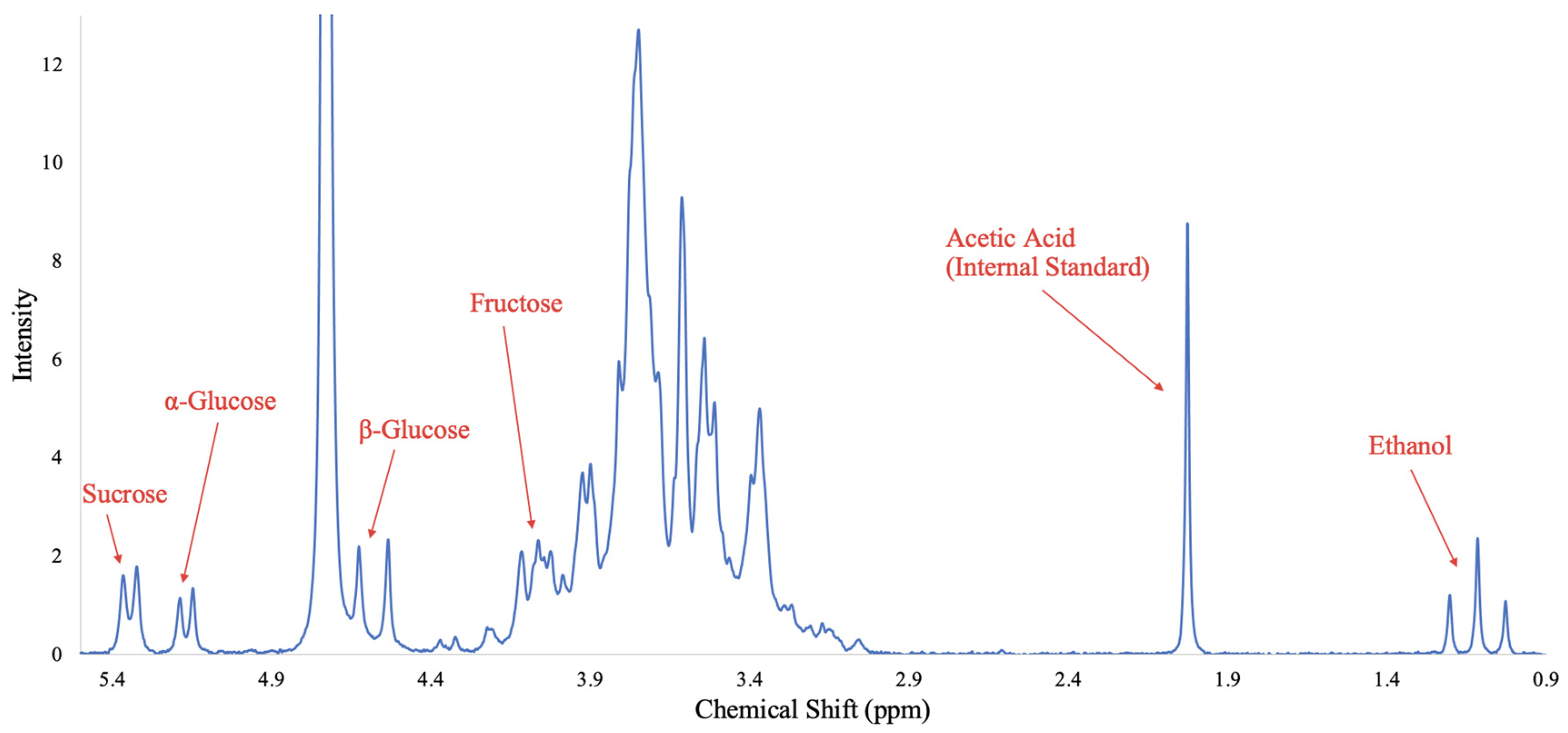

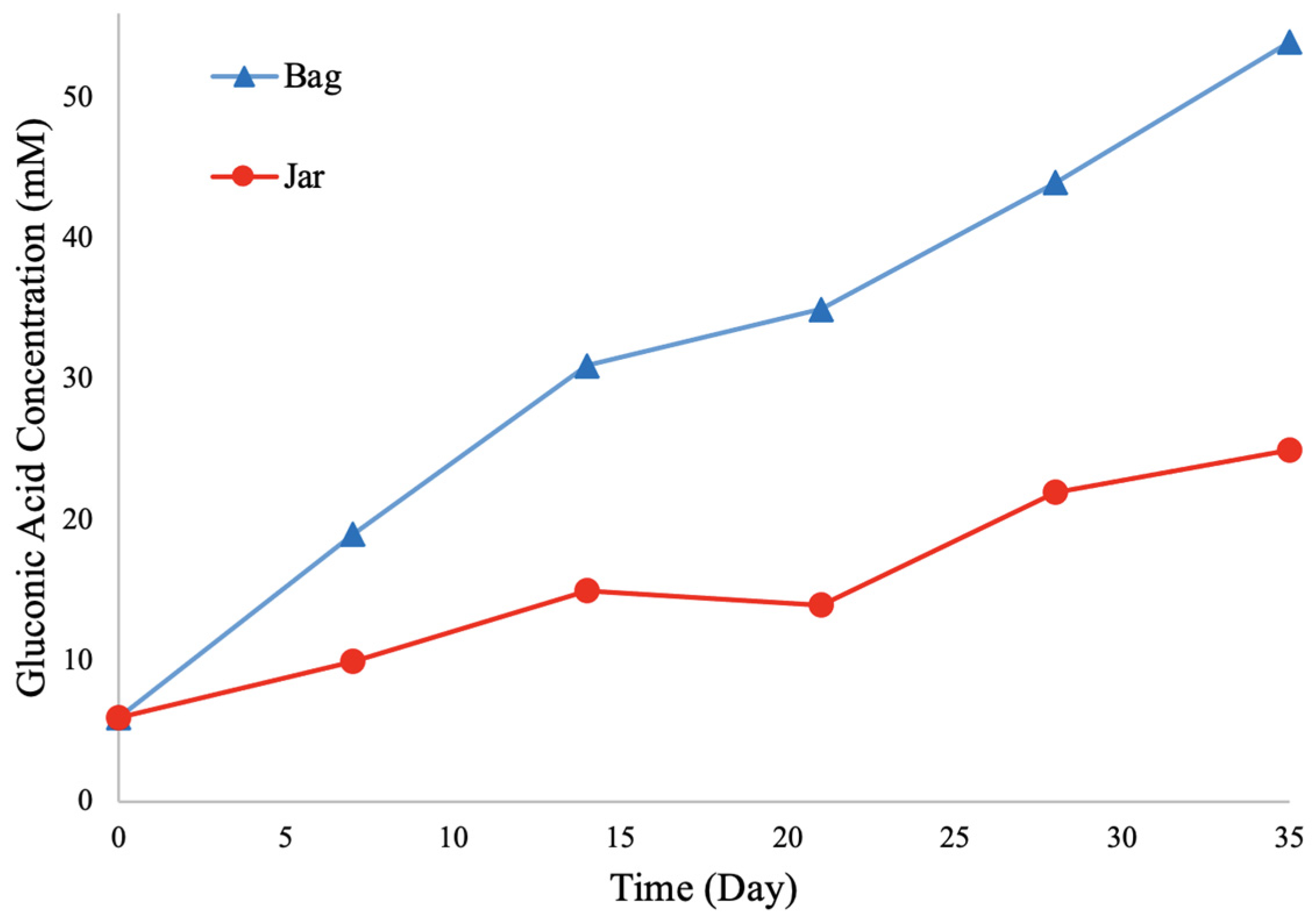
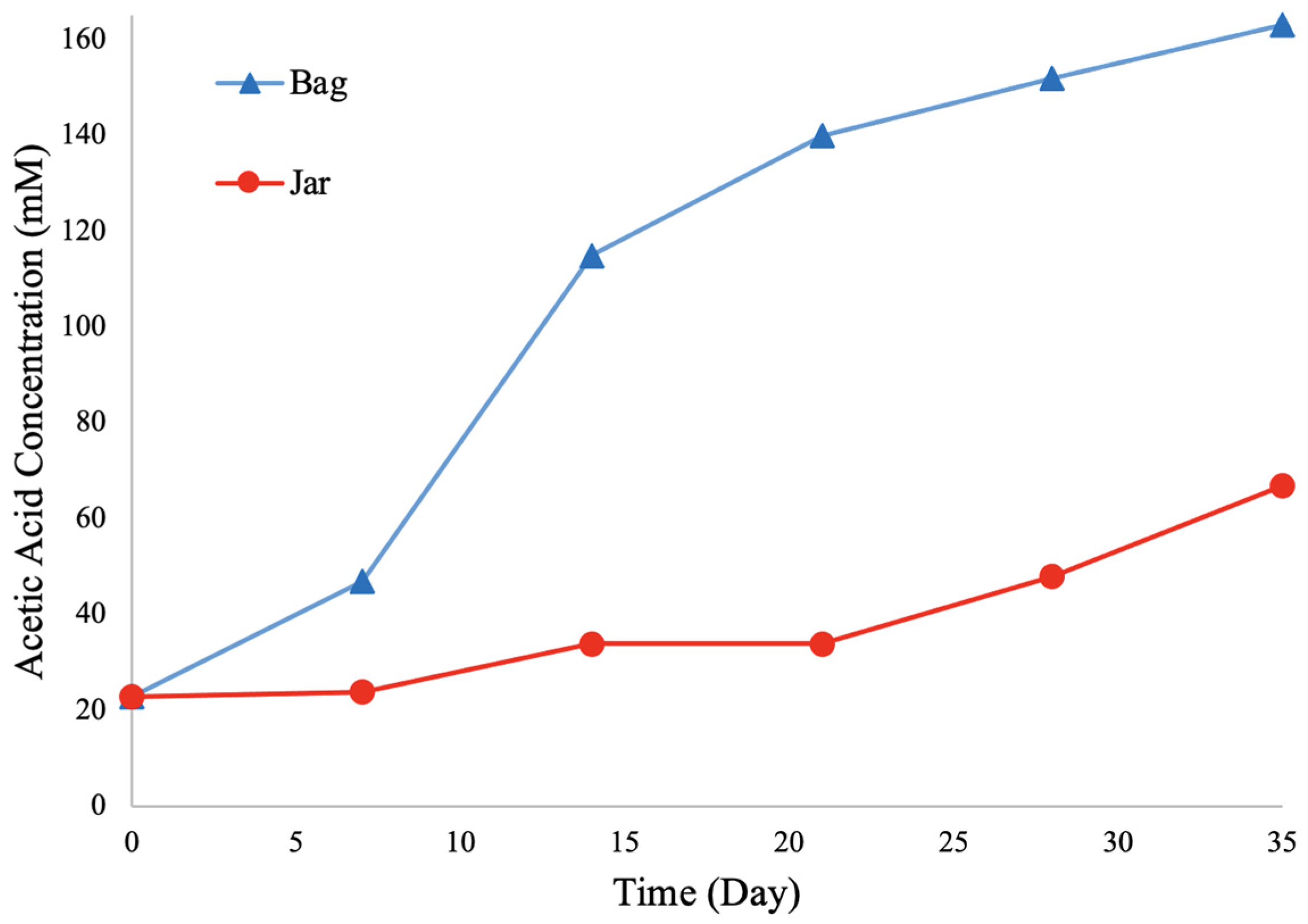
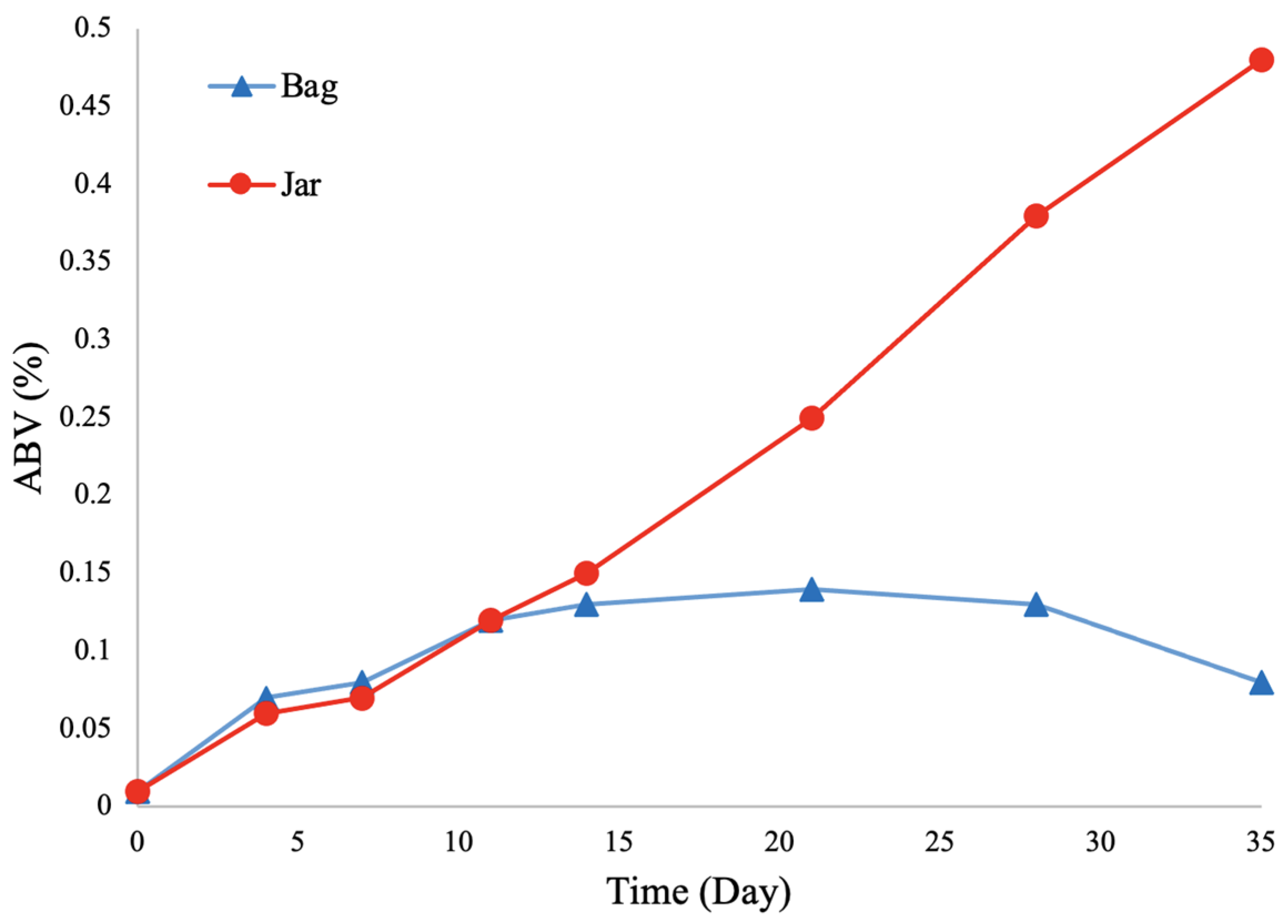

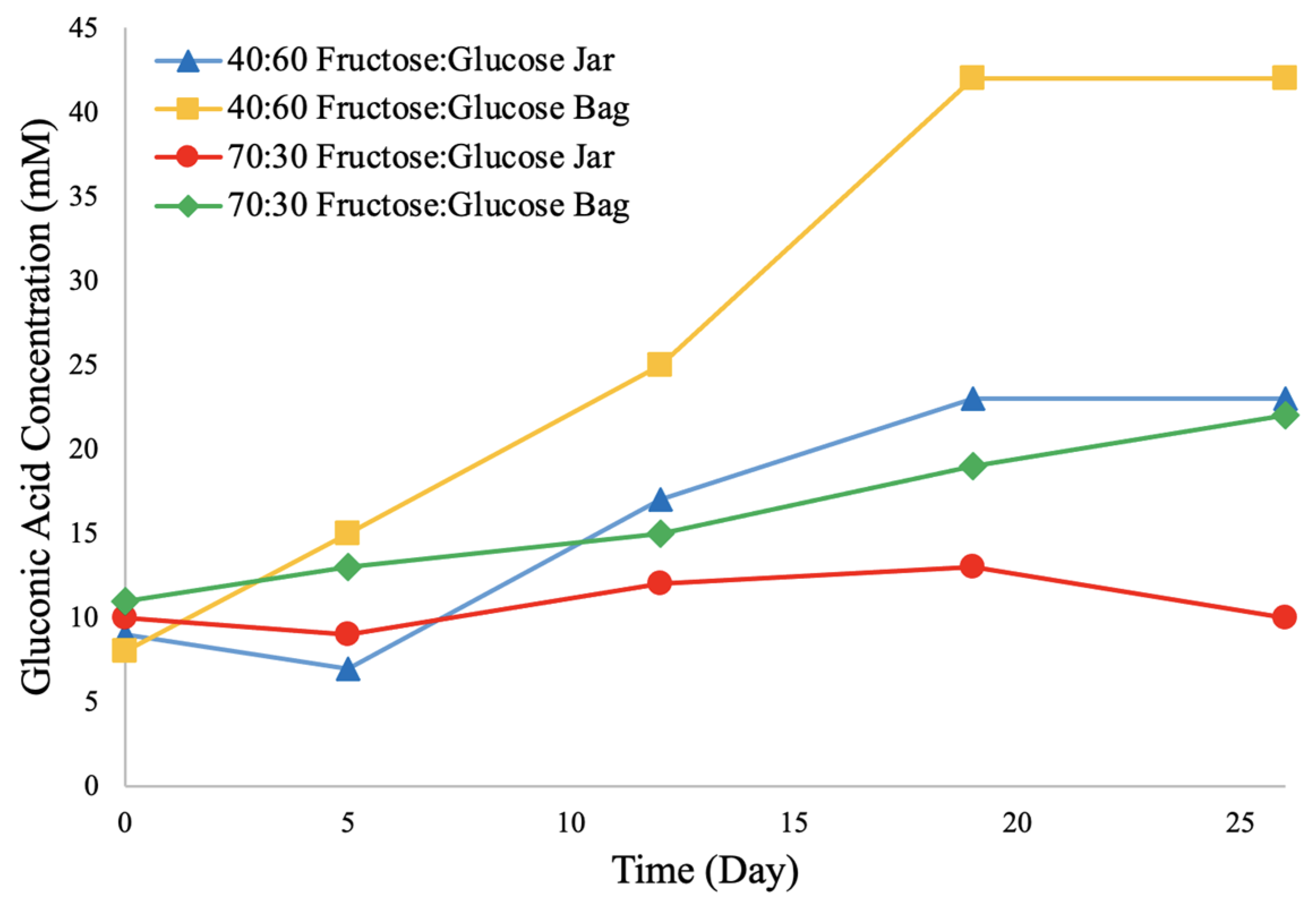
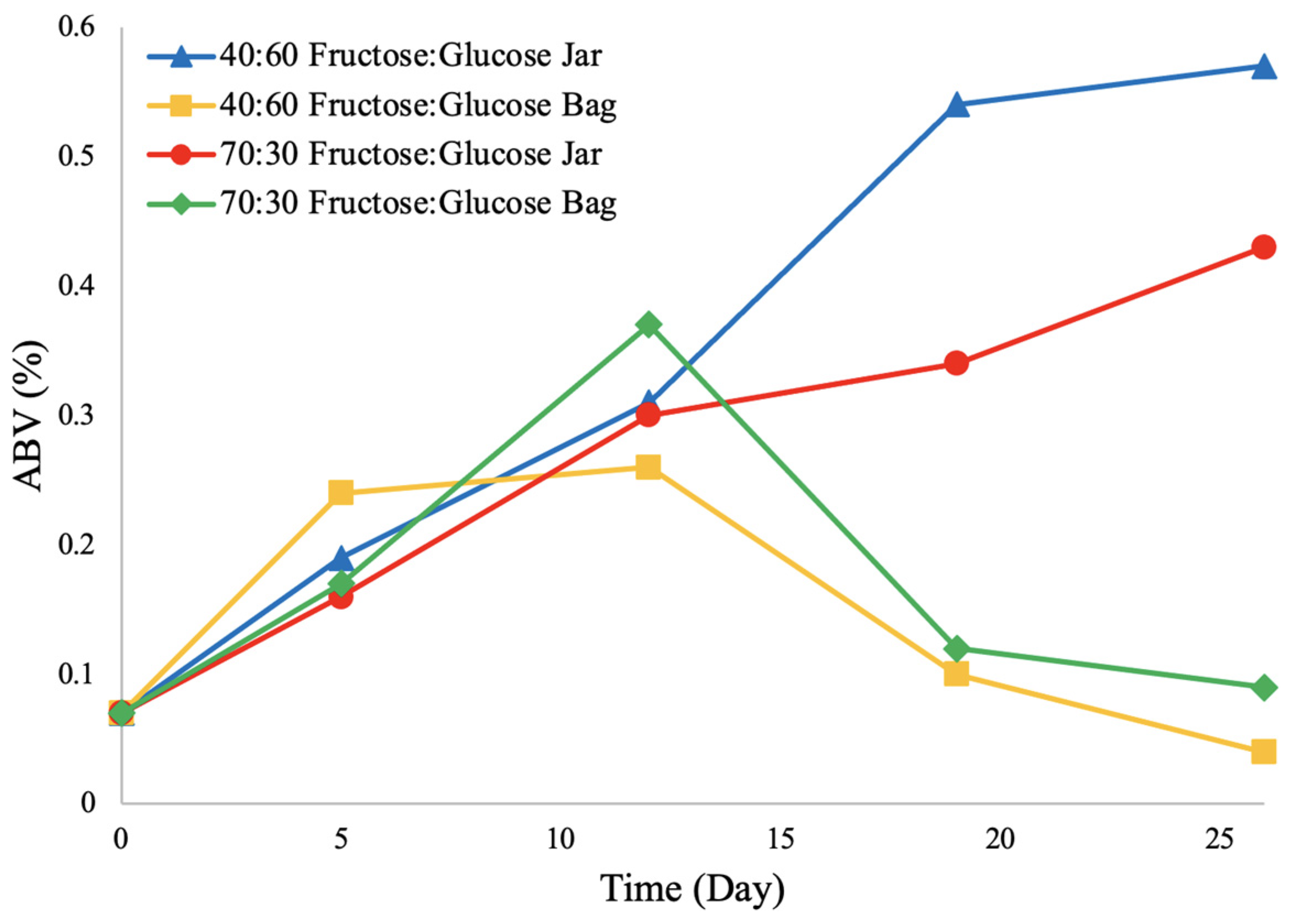
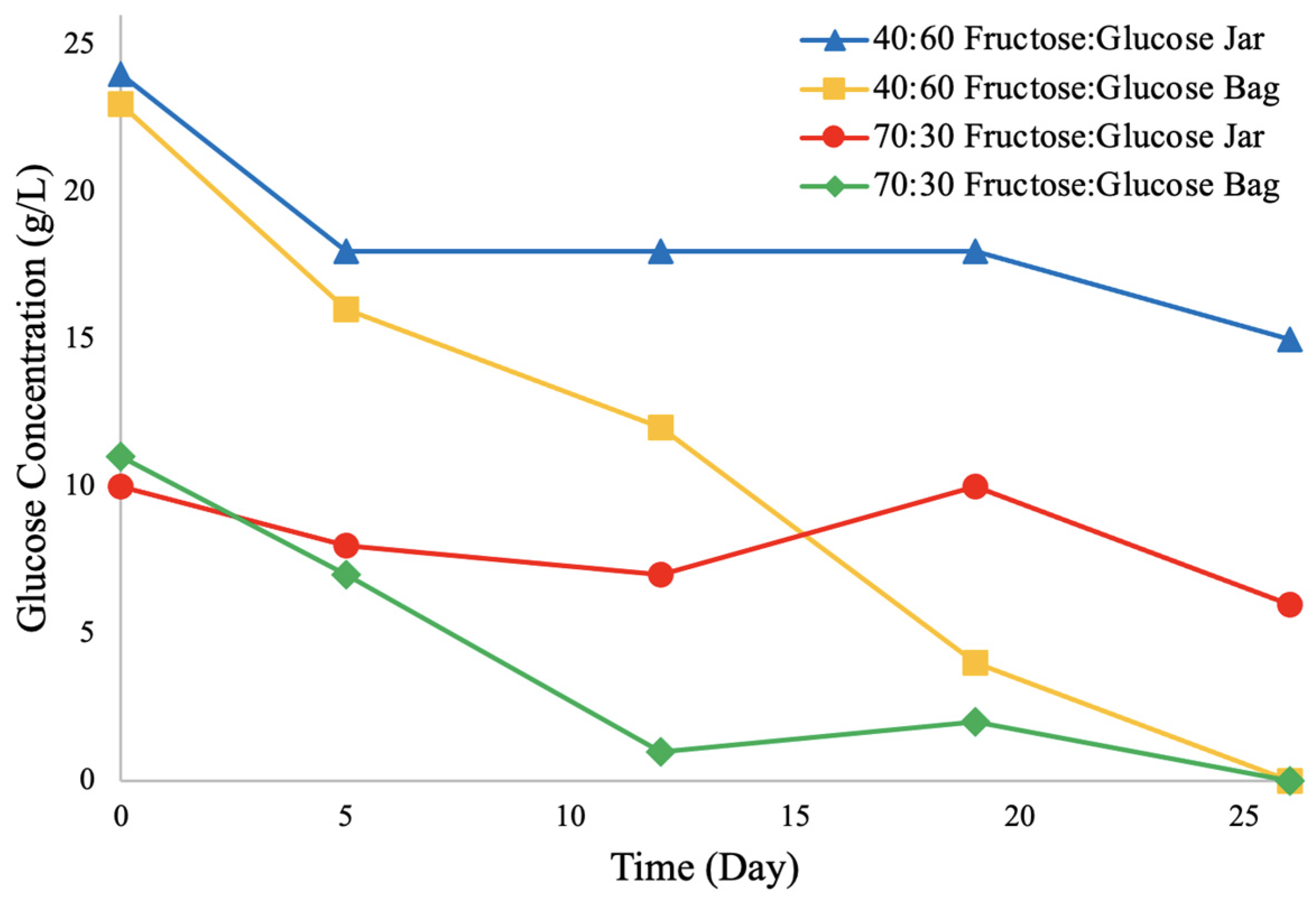
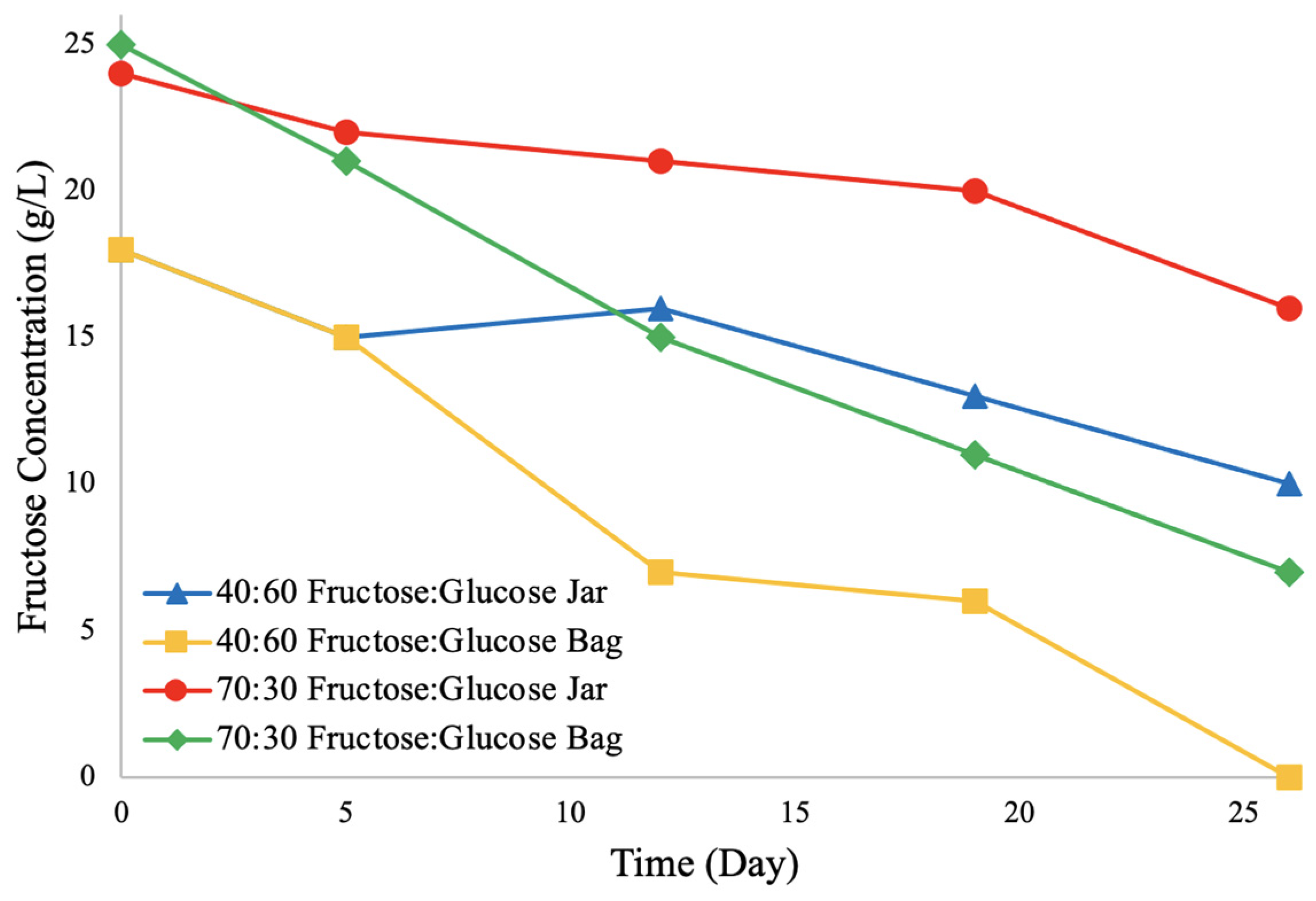


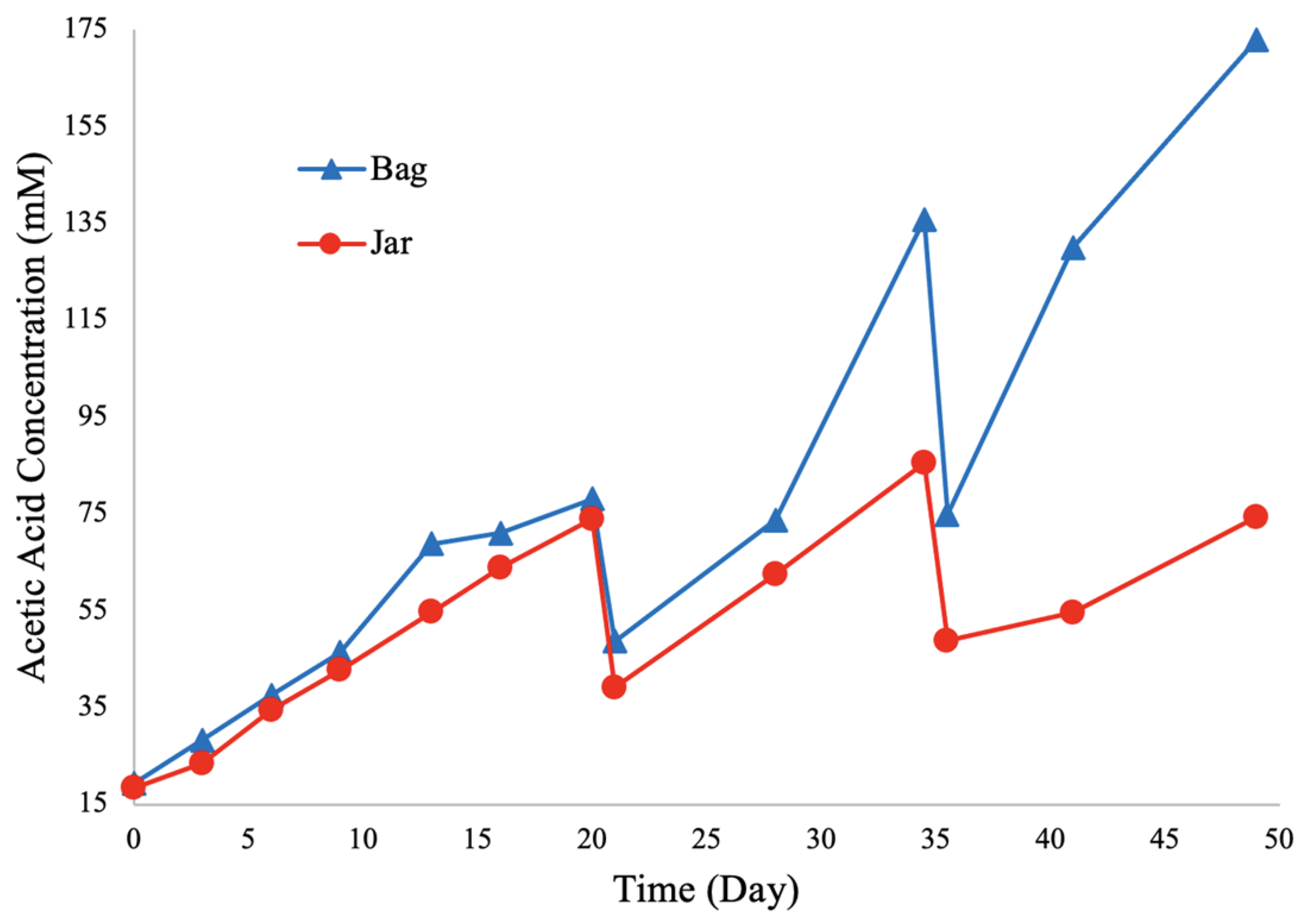
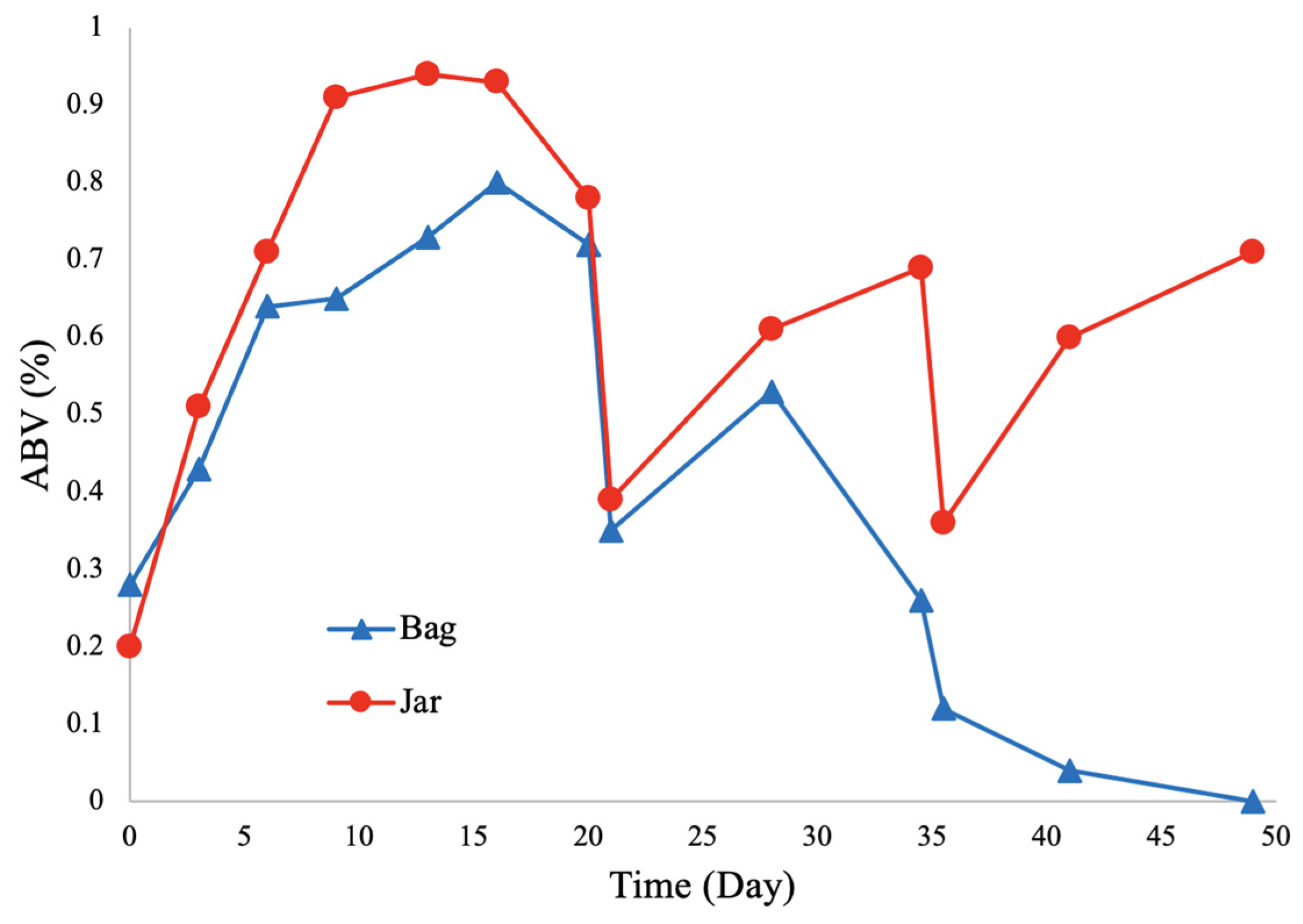
| Brewing Vessel | pH Day 0 → Day 35 | TA (mM) Day 0 → Day 35 | [O2] (ppm) Day 0 → Day 35 |
|---|---|---|---|
| Jar | 2.94 → 2.48 | 29.8 → 117 | 1.6 → 2.3 |
| Bag | 2.97 → 2.30 | 31.0 → 247 | 4.4 → 0.9 |
| Brewing Vessel | pH Day 0 → Day 26 | TA (mM) Day 0 → Day 26 | [O2] (ppm) Day 0 → Day 26 |
|---|---|---|---|
| Jar | 3.28 → 2.67 | 16.0 → 174 | 5.7 → 5.4 |
| Bag | 3.31 → 2.52 | 3.31 → 2.52 | 7.0 → 4.8 |
| Brewing Vessel | pH Day 0 → Day 26 | TA (mM) Day 0 → Day 26 | [O2] (ppm) Day 0 → Day 26 |
|---|---|---|---|
| Jar | 3.25 → 2.76 | 16.0 → 131 | 5.4→ 6.8 |
| Bag | 3.30 → 2.65 | 17.0 → 306 | 6.2 → 4.9 |
Disclaimer/Publisher’s Note: The statements, opinions and data contained in all publications are solely those of the individual author(s) and contributor(s) and not of MDPI and/or the editor(s). MDPI and/or the editor(s) disclaim responsibility for any injury to people or property resulting from any ideas, methods, instructions or products referred to in the content. |
© 2024 by the authors. Licensee MDPI, Basel, Switzerland. This article is an open access article distributed under the terms and conditions of the Creative Commons Attribution (CC BY) license (https://creativecommons.org/licenses/by/4.0/).
Share and Cite
Czarnecki, B.A.R.; Chamberlain, K.M.; Loscher, I.M.; Swartz, E.R.; Black, L.M.; Oberholtzer, E.C.; Scalia, J.C.; Watson, B.A.; Shearer, L.E.; Richardson, J.N.; et al. Optimizing Oxygen Exposure during Kombucha Brewing Using Air-Permeable Silicone Bags. Fermentation 2024, 10, 371. https://doi.org/10.3390/fermentation10070371
Czarnecki BAR, Chamberlain KM, Loscher IM, Swartz ER, Black LM, Oberholtzer EC, Scalia JC, Watson BA, Shearer LE, Richardson JN, et al. Optimizing Oxygen Exposure during Kombucha Brewing Using Air-Permeable Silicone Bags. Fermentation. 2024; 10(7):371. https://doi.org/10.3390/fermentation10070371
Chicago/Turabian StyleCzarnecki, Briana Abigail R., Kortnie M. Chamberlain, Ian M. Loscher, Emily R. Swartz, Lieke M. Black, Emma C. Oberholtzer, Jordan C. Scalia, Bret A. Watson, Lauren E. Shearer, John N. Richardson, and et al. 2024. "Optimizing Oxygen Exposure during Kombucha Brewing Using Air-Permeable Silicone Bags" Fermentation 10, no. 7: 371. https://doi.org/10.3390/fermentation10070371
APA StyleCzarnecki, B. A. R., Chamberlain, K. M., Loscher, I. M., Swartz, E. R., Black, L. M., Oberholtzer, E. C., Scalia, J. C., Watson, B. A., Shearer, L. E., Richardson, J. N., & Kegerreis, J. S. (2024). Optimizing Oxygen Exposure during Kombucha Brewing Using Air-Permeable Silicone Bags. Fermentation, 10(7), 371. https://doi.org/10.3390/fermentation10070371






